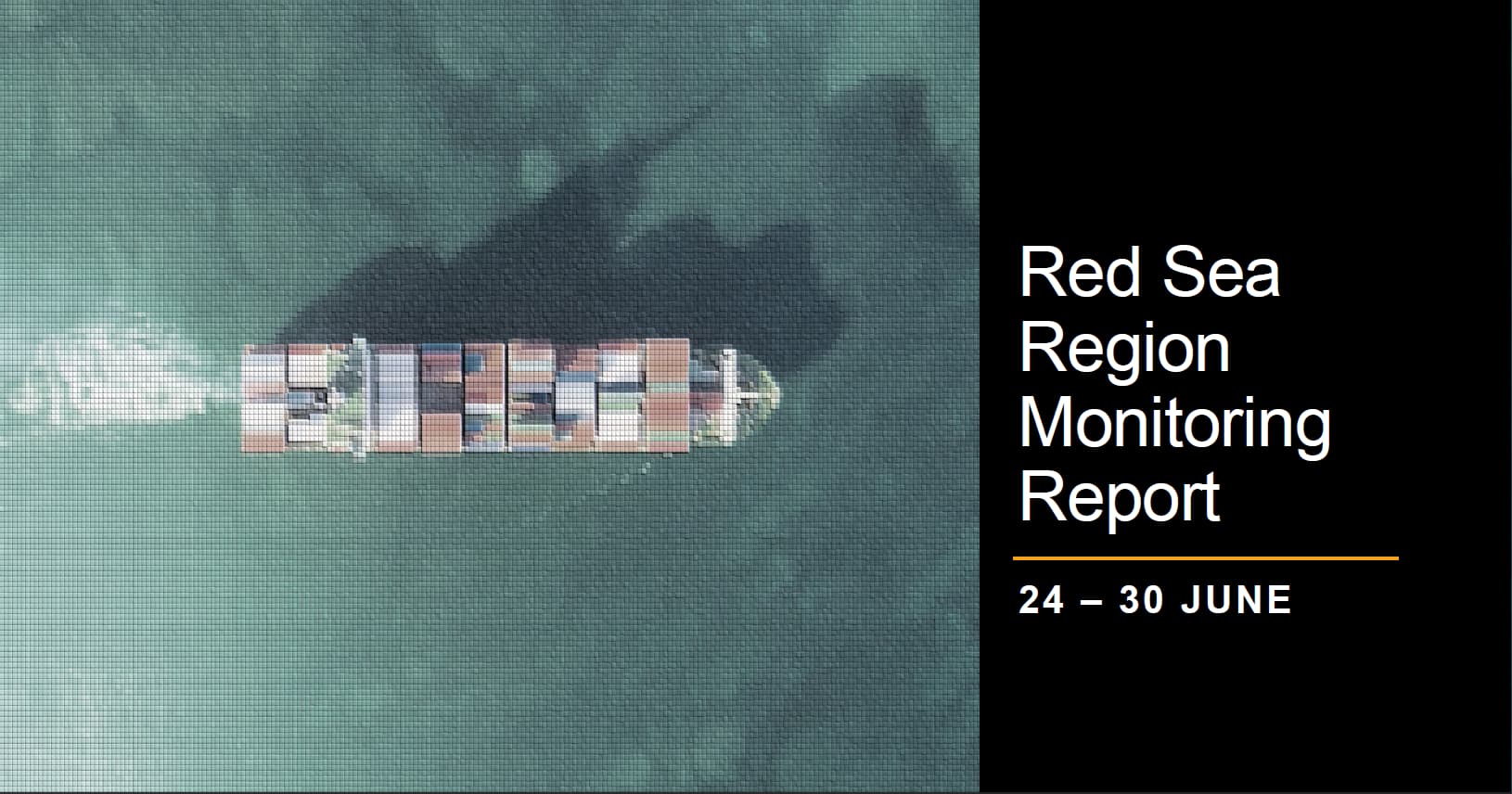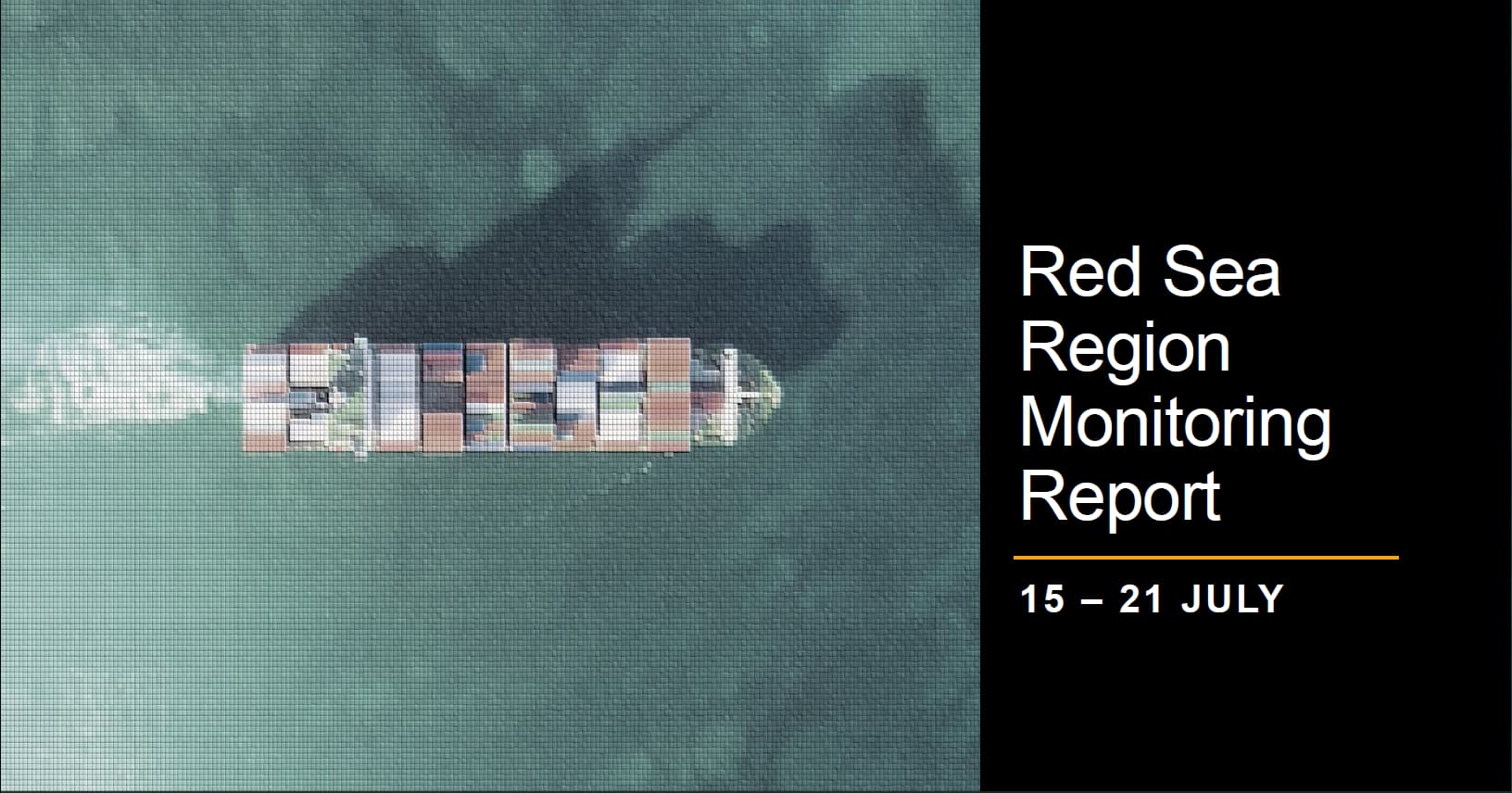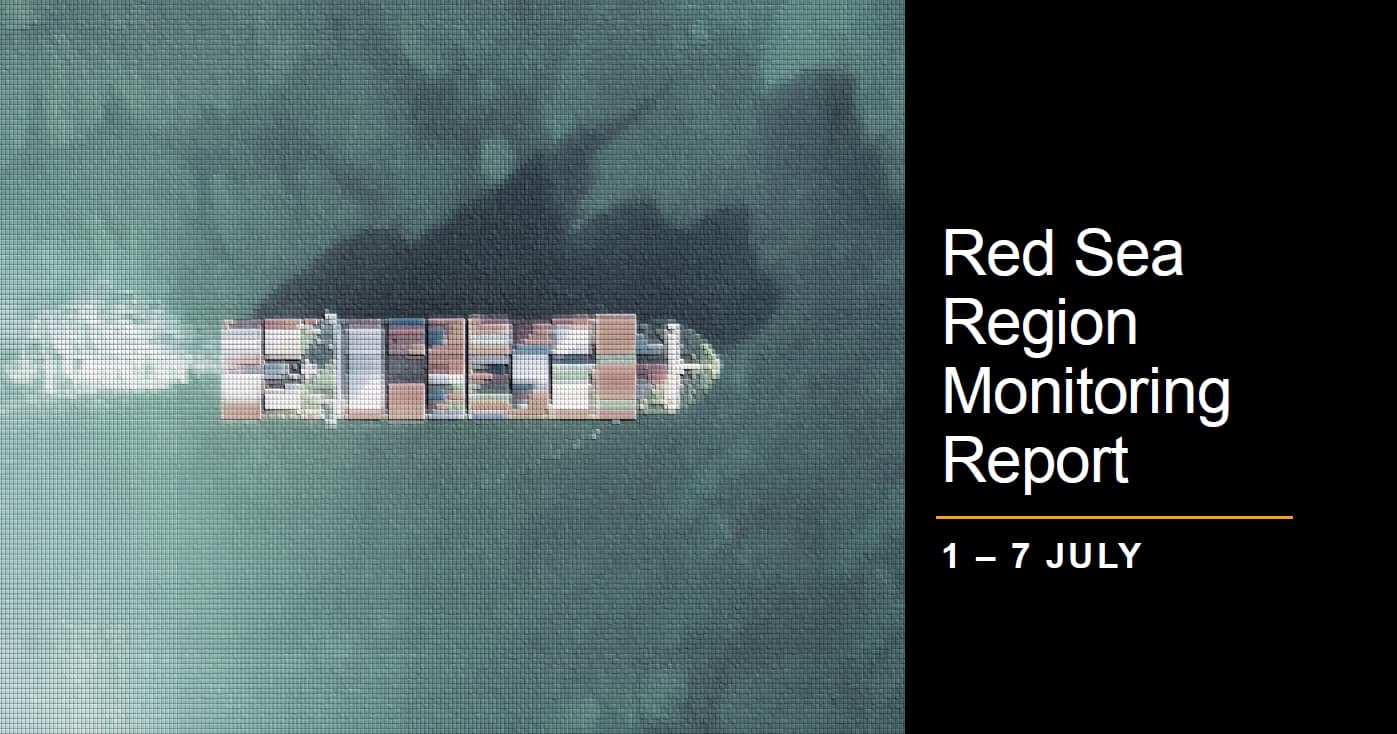KEY DEVELOPMENTS – COMMERCIAL INCIDENTS
During the monitoring period 1-7 April Regal Maritime Solutions (RMS) identified the following incidents in the Red Sea and Gulf of Aden region:
MISSILE ATTACK: On 1 April there was a report of a suspected attack in the vicinity 150NM north west of Al-Hudaydah in the Red Sea
MISSILE ATTACK: Incident reported 60NM southwest of Al-Hudaydah after two missiles were report close to the vicinity of a commercial vessel. The first missile was intercepted by coalition navy vessels and the second impacted the water some distance from the vessel. The vessel reported no damage or injury to the crew and continued to its next port of call.
MISSILE ATTACK: On 7 April there was a report of a suspected attack in the Gulf of Aden approximately 77NM west of Aden.
UNCORROBORATED MISSILE ATTACKS: On 7 April Houthi militants claimed to have targeted the British vessel Hope Island in the Red Sea and the MSC Gina and MSC Grace F. If true, and despite the lack of reporting of such incidents, these attacks ultimately failed to impact. No suspicious incidents of such an attack have been reported. In addition, if ture, this would suggest an expansion to the maritime risk area posed by Houthi attacks.

KEY DEVELOPMENTS – MILITARY ACTIVITY
During the monitoring period 1-7 April RMS identified the following incidents involving US coalition forces in the Red Sea and Gulf of Aden region, obtained from military and open sources:
On 1 April at approximately 0900 local time the US military identified and destroyed a Houthi launched unmanned surface vessel (USV). The USV was determined as presenting a threat to US and coalition forces and commercial vessels in the region and employed direct action in self- defence.
On 3 April between 0345 and 1000 local time the US warship, USS Gravely identified one inbound anti-ship ballistic missile (ASBM) and two unmanned aerial vehicles (UAV) launched by Yemen based Houthi militants in the Red Sea. The USS Gravely determined the weapon systems as a direct threat to US, coalition and commercial vessels in the region and engaged and destroyed all three targets. There no reported damage to any vessels in the region as a result of the action or injury to any personnel.
On 4 April at approximately 1420 local time, US forces conducted a pre-emotive strike on Houthi controlled territory of Yemen and successfully destroyed one anti-ship missile (ASM) considered an imminent threat to shipping in the region.
On 6 April between 1000 and 1700 local time the US military intercepted and destroyed one UAV flying and one inbound anti-ship missile over the Red Sea. In addition the European Union’s naval mission in the southern Red Sea ASPIDES confirmed the German warship Hessen intercepted an inbound anti-ship missile launched from Houthi controlled territories.
KEY DEVELOPMENTS – HOUTHI MISSILE STATISTICS

Figures 1 and 2 identifies the number of missiles, UAV, USVs and UUVs launched, or prepared to be imminently launched, by Houthi militants from Yemen targeting commercial and naval vessels in the Red Sea and Gulf of Aden regions. Figures have incorporated statistics from vessels hit, near misses and pre-emptive strikes on-land in Yemen by US-led Coalition forces but not those resulting from large scale coordinated military action. In some cases the destined target of Houthi weapons including destroyed on-land in Yemen cannot not be verified and has therefore been categorised as ‘Not Known’ (NK). Where no dates are provided there were no reported incidents or data available for that period.
KEY DEVELOPMENTS – SECURITY INCIDENT MAPPING

REGIONAL DEVELOPMENTS
During the monitoring period 1-7 April RMS identified the following key regional developments:
The past week saw an increase in attacks on commercial shipping in the Red Sea following a lull of several days between 23 March and 1 April which marked the longest period without incident since December 2023. Very limited attacks continued on US and coalition warships.
The US military suggest Houthi militants may be running low on weapon stocks following recent strikes by US and UK forces which may have been a contributing factor as to why attacks on commercial vessels had slowed recently. Whilst a full impact assessment on US strikes on Houthi positions is hard to ascertain considering the limited intelligence assessment of Houthi capabilities before attacks began, the recent reduction in tempo of attacks may suggest them to be running low on UAV and ballistic missile supplies. The US acknowledged the ongoing challenge to interdict and mitigate Iranian weapon re-supplies.
On 7 April Houthi militants claimed to have targeted British, Israeli and US vessels in five military operations over the past 72 hours from rocket and UAV attacks off the Yemeni coast. In a televised statement, Houthi spokesman, Yahya Saree, claimed responsibility for the attacks which also included a number of US and coalition warships in the Red Sea. The Houthis claimed a direct strike on the British container ship Hope Island, which has not been corroborated; as well as two other vessels the Houthis categorised as “Israeli ships”, the MSC Grace F and MSC Gina. Both these vessels were located outside the Houthi danger area in the Indian ocean and Arabian sea respectively. So far there have been no claims of any incident. There are no corroborating sources of this claim beyond the Houthi statement.
The last reported location of the Iranian intelligence vessel the Behshad was on 4 April in the vicinity of coordinates 11° 00′ 34.7″ N, 044° 17′ 39.5″ E located approximately 28.5NM north-east of Lughaya., Somalia.
The EU’s operation ASPIDES in the Red Sea aimed at protecting commercial ships from Houthi attacks has so far escorted 68 vessels and repelled 11 attacks, but remains limited to operating in a small operational area due to a lack of ships and other assets.
On 1 April an airstrike targeted the Iranian consulate in Damascus, Syria killing senior Iranian Republic Guard Corps (IRGC) Al Quds commander, Brigadier General Mohammad Reza Zahed, amongst other IRGC advisors. The Iranians suspect Israel to be responsible for the airstrike and have warned of retaliation for the attack.
Israeli Prime Minister Benjamin Netanyahu has warned Iran against any action claiming the country will defend itself against any action, which may result in an escalation of conflict in the region. On 4 April Israel scrambled GPS navigational signals over the Tel Aviv metropolitan area as an electronic counter measure to disrupt any potential Iranian or proxy attack on the economic centre from UAVs or missiles. Israeli government establishments including its embassies overseas have been identified as potential targets. The action follows anticipated retaliatory action by Iran in response to the attack in Syria.
On 5 April Iran-backed Lebanese militant group, Hezbollah confirmed its support for Iran’s right to “punish” Israel, during televised remarks by Hezbollah’s leader Sayyed Hassan Nasrallah, who also confirmed a response was coming.
The US has warned Iran not to attack any US facilities following the suspected Israeli airstrike on the Iranian consulate in Syria. Iranian political advisor, Ali Shamkhani warned in a post that the US ‘remains directly responsible whether or not it was aware of the intention to carry out this attack’.
The Israeli Defense Force (IDF) has withdrawn forces from Khan Younis in southern Gaza amid reports of a possible ceasefire agreement with Hamas, something which Hamas has so far denied.
Russian warships from its Pacific Fleet crossed the Bab-el-Mandeb Strait and entered the Red Sea during the week, venturing into the maritime region where a number of multinational naval vessels are operating to counter Houthi attacks on commercial shipping. It remains unclear the reason the Russian vessels were sent to the area.
A security alert has been issued by the US state department regarding potential terrorist threats to multiple locations in Mogadishu, Somalia including the Aden Adde international airport.
ASSESSMENT
- Houthi attacks will continue to target commercial and military vessels in the Red Sea and Gulf of Aden despite the recent lull on attacks. Houthi militants will continue to target vessels with suspected links to Israel, the US and the UK.
- Claims by the Houthi group to have targeted the commercial vessels, Hope Island, MSC Gina and MSC Grace have not been corroborated. If these vessels were indeed the intended target of potential strikes, it would have far exceeded the current Houthi danger area and constitute an expansion of the maritime risk area.
- Any ceasefire between Israel and Hamas, may see a pause in attacks by the Houthis on commercial shipping. However this may be influenced from occurring in the event of potential retaliatory action by Iran and its regional proxies against Israel as a consequence of the attack on the Iranian consulate in Syria.
- Iran will be exploring potential Israeli targets to carry out retaliatory strikes against in the region and possibly internationally, utilising its own agents and regional proxies. Iran’s response will likely remain focused against Israeli targets rather than US as to avoid the potential for wider regional conflict between major powers.
- Iran will be considering how Houthi capabilities can be utilised as part of retaliatory strikes in the region against Israeli interests, should it look to complement or enhance its wider strategic objectives.
- Iran will continue to smuggle weapon components to Houthi militants via shipping vessels and smuggling networks within the territory controlled by Yemen’s internationally recognised government (IRG).
- Houthi use of outdated and inaccurate data pertaining to target identification will likely remain inaccurate in the short term increasing the risk to non Israeli, US or UK linked vessels. Houthi militants are expected to take additional precautions not to target Chinese and Russian vessels in the region
- The US and its partners will continue to conduct pre-emptive strikes against Houthi targets on- land in an attempt to degrade Houthi military capability.
- The US will continue to intensify efforts to intercept vessels smuggling weapon components from Iran to the Houthis in Yemen and expand intelligence collection methods to enhance maritime interdiction operations, as well as coordinate military strikes against Houthi weapon sites, facilities and capabilities in Yemen.
- The US government will continue to push for a diplomatic solution for the Israel-Hamas conflict with regional partners due to the ongoing humanitarian crisis in Gaza and attempt to dissuade wider conflict from escalating in the region.
- Piracy incidents around the Horn of Africa is expected to continue as a consequence of ongoing insecurity challenges presented in the Red Sea region as a consequence of ongoing Houthi attacks.
- The Indian navy will continue to utilise coercive measures to resolve piracy incidents and to deter PAG activity in the Indian ocean region.
RECOMMENDATIONS
- Avoid being in vicinity of Iranian Behshad vessel.
- Be aware of potential US, coalition or Israeli Navy activity nearby in north of Red Sea, Bab-al-Mandab strait and Gulf of Aden.
- Vessels operating in the Indian Ocean area are urged to heighten their vigilance due to increased likelihood of Pirate Activity Groups (PAGs) operating in the area.
- Report any Suspicious Sightings and be aware of the risk of Unmanned aerial Vehicle (UAV) / drone and Uncrewed Surface Vehicle (USV) attack.
- Consider utilising a digital monitoring system, which incorporates UAV/UUV drone monitoring to warn of potential attack and use of physical barriers, such as nets and underwater barriers, that can be deployed to prevent UUVs from approaching a ship. These barriers can entangle or obstruct the movement of a UUV.
- Ensure crew conduct drills and training exercises to respond to UUV threats so that they are well-prepared to take appropriate action in the event of an incident.
- Follow guidance on loitering munitions as per the OCIMF website: https://www.ocimf.org/publications/information-papers/loitering-munitions-%E2%80%93-the-threat-to-merchant-ships
- Implement and review BMP5 in particular section 2, which describes non-piracy threats and the Global Anti-Piracy Guide.
- Consider mentioning vessel location to Flag Authorities.
- Inform UKMTO/MSCHoA of vessel movements.
- Ensure radar is kept on.
- Communicate with local agents for any local information or intelligence.
- Keep VHF Ch16 on and pay attention to advisories. Ensure strict surveillance of communications and establish communication with all approaching vessels.
- Do not allow small boats to approach or dock. Consider utilizing an armed security team aboard.
- Ensure there is Hard Cover available if on deck and that it is accessible.
- Ensure a Secondary Muster Station is considered and identified to crew and not just the citadel.
- Maintain Bridge Watches. (Please be aware at night, small, slow vessels without a wake are difficult to detect on radar). Keep Traffic on Upper Deck to a minimum
- Ensure all fire-fighting equipment is checked and available for immediate use. Including the emergency fire pump and that relevant maintenance has been conducted.





